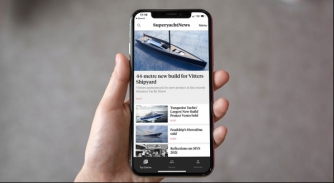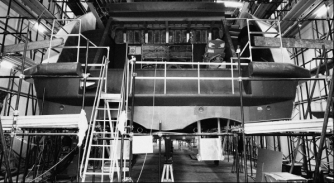A lot of waste
Might a realignment of priorities allow the application process to reduce its waste significantly?
Paint and application remain one of the most fraught elements of any superyacht build and yet, to a certain extent, it also remains one of the most archaic and wasteful. With the adoption of new technologies and a realignment of priorities, might the sector have an opportunity to significantly reduce its environmental footprint?
“The application sector is producing a better quality of finish on the whole than it ever has done before,” starts Remy Millott, CEO of GYG plc, the parent company of Pinmar. “That isn’t just because we are using new products and technologies, such as spray filler and electrostatic application, both of which have a significant impact on the environment, quality and cost, but also because we are working more closely with the shipyards and manufacturers. There is better management, better planning and greater control. However, the amount of waste from the application process still concerns me.”
The problem with waste is twofold. Firstly, the industry has been slow to adopt the technologies that Millott cites. Once again, the market’s development has stagnated to a certain extent because of its conservatism and its aversion to perceived risk. Secondly, the determination of third parties and owner’s teams to often find fault where no others would observe them has meant that work is often repeated at an additional financial, time and environmental cost.
It will come as absolutely no surprise to most that the new build and refit markets, generally speaking, have been slow to come to terms with new technology and, quite frankly, this is not entirely without good reason. The sums of money at stake, especially for large custom new builds, are significant where paint is concerned and, as such, there is a very real financial risk to adopting technologies. Being risk-averse is not, in and of itself, a bad thing. Nevertheless, there will come a time soon when the technologies have been proven to the nth degree that the market leaders will have to step forward into the next iteration of application and, most likely, reap the benefits that new technologies confer.
“This industry is always slow to make changes, especially where exterior paint is concerned,” continues Millott. “Systems, working practices and principles have been embedded for a long time. The industry has moved on hugely in other areas such as hybrid propulsion, electronics and design. However, the yacht painting business hasn’t moved on at all really in terms of the products and the way most apply them, and it is time that we did. Reducing the manpower and time required to fair boats, especially on large new build projects where it takes months of laying on filler, in a relatively short outfitting period, is essential. Using a sprayable filler can reduce the time required for the sanding process by 8-10 times, which will improve the general working conditions during outfitting, it is also significantly better for the environment in terms of waste. I truly hope the industry accepts the new technology with open arms. We are in the process of fairing two yachts with that system and we’re looking forward to showing the industry the results.”
Millott further explains that 95 per cent of all Pinmar’s topcoats are now applied electrostatically, which cuts down top coating periods, creates a better-quality finish over larger surfaces and reduces the environmental impact due to significantly better transfer efficiency of the topcoats. “We are invested in using technologies that yield a positive impact for the shipyards, the clients, the environment and better overall long-term performance for the owners.”
However, technology is only one part of the solution for reducing waste. Where paint is concerned it is well known that small issues require large expensive fixes. While no one is suggesting that the superyacht industry should become accustomed to accepting poorer standards of work, there is an argument that minuscule blemishes that are unobservable to owners, guests or onlookers should perhaps be, on occasion, overlooked given the financial and environmental cost of repainting large areas.
“It still concerns me the amount of waste that we go through. If you consider the amount of material that is wasted on a refit or new build accounting for small defects, it strikes me that the priorities are out of line. Rather than finding unobservable faults, we should be focused on the overall quality and technical performance of a finish. We need to stop searching for micro faults that fall just outside of the specification when it takes another three weeks to repaint something that no one will ever notice,” continues Millott. “The wastage is huge and principles need to change. I never have a problem repeating works where it is required, but when we are talking about repainting large areas because of a minor fault, where guests need to crawl round on their hands and knees to see it, doesn’t make sense. This is just not good value for the client or the shipyard. I always say to clients, let’s invest the time and money where it matters.”
Where minor faults that fall outside the spec are concerned, are owners made fully aware of the extra time, financial and environmental costs of fixing the issue? I wonder if their opinions would change if they were given the opportunity to make a judgement call that falls in line with their priorities? The application industry has an opportunity to greatly improve with the adoption of new technologies and a realignment of priorities. The only question that remains then is how important are these of wastage and environmental impacts to the industry?
For an in-depth look at the future of the paint and application sector, look out for the publication of The Superyacht Refit Report. Alternatively, get your Essential or Executive Membership packages here and never miss an issue.
Profile links
NEW: Sign up for SuperyachtNewsweek!
Get the latest weekly news, in-depth reports, intelligence, and strategic insights, delivered directly from The Superyacht Group's editors and market analysts.
Stay at the forefront of the superyacht industry with SuperyachtNewsweek
Click here to become part of The Superyacht Group community, and join us in our mission to make this industry accessible to all, and prosperous for the long-term. We are offering access to the superyacht industry’s most comprehensive and longstanding archive of business-critical information, as well as a comprehensive, real-time superyacht fleet database, for just £10 per month, because we are One Industry with One Mission. Sign up here.
Related news

Managing glamorous money
Jane Turner, CEO of fintech company Centtrip, discusses money management in the superyacht industry
Crew

Out now, the new SuperyachtNews app!
The new SuperyachtNews app provides access to business-critical news, data, video content and various communications and events features
Business

A new build quandary
Has the threat of inflation and rising raw material costs created a win-win or a lose-lose scenario?
Owner

The Millennial takeover ??
Everyone in the industry is talking about the next generation, but what does that actually mean?
Business

The pricing problem
Could the shift into a sellers’ market have a long-term impact on pricing for the brokerage sector?
Owner
.jpg)
Monaco Yacht Show team issues statement on the show
The MYS team reflect on the show's new format and look towards future iterations
Business
Related news
Managing glamorous money
4 years ago
Out now, the new SuperyachtNews app!
4 years ago
A new build quandary
4 years ago
The Millennial takeover ??
4 years ago
The pricing problem
4 years ago
NEW: Sign up for
SuperyachtNewsweek!
Get the latest weekly news, in-depth reports, intelligence, and strategic insights, delivered directly from The Superyacht Group's editors and market analysts.
Stay at the forefront of the superyacht industry with SuperyachtNewsweek



